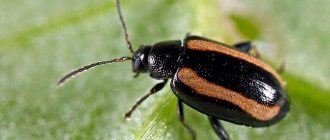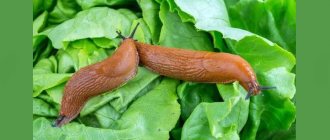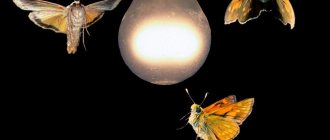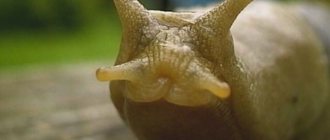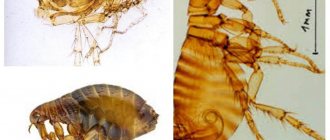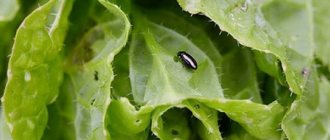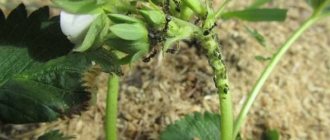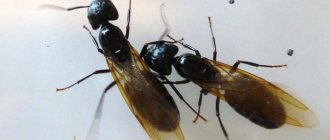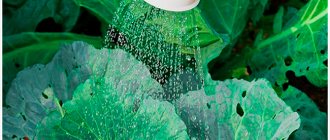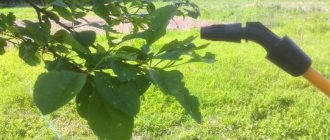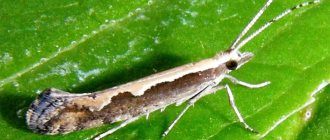Experienced gardeners have already collected a whole collection of measures and tips on how to protect cabbage from flea beetles so as not to be left without a harvest. Agricultural technicians constantly remind about preventive measures: it is easier to prevent than to abandon other gardening chores and fight for cruciferous crops. Agrochemistry offers a full range of drugs to quickly get rid of the scourge.
There is full combat readiness on all fronts, but sooner or later the pest still attacks radishes, cabbage (of all types), fodder root crops, and mustard. Knowing the enemy by sight, they enter the fight at the first sign of a threat.
How dangerous is a flea?
Phyllotreta cruciferae is an agricultural pest, a type of flea beetle from the Leaf Beetle family, devouring cruciferous crops, including cabbage. They are small beetles with a body length of 2-3 mm and jumping limbs. The integumentary coloration depends on the species; usually the black flea beetle may have a greenish or metallic tint, yellow legs or stripes on the elytra.
The tiny bug jumps several meters and moves very quickly.
In the countries of the former Soviet Union, the cabbage flea beetle is widespread wherever there are cultivated or wild plants from the Cruciferous (Cabbage) family. The 4 most common species of Phyllotreta are:
- Nemorum (light-footed) - lives in the south of the forest zone. The flea prefers to gnaw and mine the leaves of cabbage and other cruciferous vegetables.
- Undulata (wavy) is found in the north of the European part, the Far East, the Urals, and Siberia. Adults skeletonize leaves, larvae eat lateral roots.
- Atra (southern or black flea beetle) is the most dangerous pest of cruciferous crops, despite its name, it lives throughout the species’ distribution range. Beetles gnaw the leaves; the larvae prefer small roots.
- Vittata (notched) feeds and parasitizes mainly on oilseed cruciferous crops in the Amur region, Primorye, and southern Yakutia.
Flea beetles overwinter in the ground, under leaves, and in cracks of wooden structures. Before early radishes emerge and cabbage is planted in the ground, they parasitize weedy cruciferous crops:
- rapeseed;
- mustard;
- shepherd's purse;
- Yakut;
- wild radish.
If cabbage seedlings are grown in a poorly treated greenhouse, flea beetles can destroy them before moving them to a permanent location. Pests gnaw holes, sometimes completely skeletonize young leaves, scraping off the skin. Old leaves are hard, covered with a waxy coating, and pests like them much less.
Black flea beetles on Chinese cabbage cause the most harm. Its leaves remain tender until harvest. Often, when you cut a beautiful-looking fork, you can find a whole colony of insects inside.
The larvae develop under the cabbage bush and pupate there. They feed on lateral sucking shoots and often eat up the root collar.
Pests are most active as soon as the temperature rises to 15°C. If spring is warm and early, it is difficult to save cabbage seedlings from flea beetles without using chemicals - they can eat the entire garden bed.
During the rainy season or with frequent watering, the activity of Phyllotreta cruciferae decreases, but pathogenic microorganisms invade damaged leaves. Flea beetles switch to ornamental crops - roses, lilies.
Important! The second generation of pests appears in July.
Danger to cabbage
Tender leaves of young cabbage are a delicacy for voracious cruciferous flea beetles, which attack the crop in early summer and actively eat it. Cabbage is most vulnerable when it is still in the seedling stage, having just been transplanted to a permanent place of residence.
Expert opinion
Stanislav Pavlovich
Gardener with 17 years of experience and our expert
Ask a Question
Pests eat cabbage leaves so that they become like a sieve. The uneaten part of the leaf dries out immediately. As a result, the cabbage does not have time to set a head and dies. If the young seedlings were protected from the invasion of the cruciferous flea beetle, and the heads of cabbage had time to set, and the leaves became tougher, then you no longer need to be afraid of this insect.
Prevention of pest occurrence
Correct agricultural technology will not prevent black flea infestation of cabbage - thanks to its high jumping ability, the insect will get away from its neighbors even over the fence. But this will delay the appearance of the pest and reduce the damage.
Preventive measures:
- compliance with crop rotation;
- dressing cabbage seeds;
- regular weeding;
- digging the beds in the fall - cruciferous flea beetles wintering in the upper layers of the soil will die from frost;
- destruction of plant residues at the end of the season;
- planting garlic, nightshade crops and aromatic plants next to cabbage - their smell repels black flea beetles;
- frequent overhead watering;
- regular fertilizing with organic matter;
- preventative treatments;
- You should not leave cruciferous weeds pulled out or chopped with a hoe in the garden.
Diseases and pests of Chinese cabbage, how to deal with them
Cabbage is a healthy vegetable, rich in vitamins and microelements. There are a great many varieties, but each of them occupies a special place in the human diet. From the name it becomes clear where this culture comes from.
However, it is now successfully grown not only in China, but also in Russia and other countries. Chinese cabbage has gained its popularity among gardeners and agronomists due to its unpretentiousness and fertility. It will grow well both on a personal plot in open ground and in a greenhouse. But one thing overshadows it - susceptibility to various diseases and the onslaught of pests.
Chemical control agents
Methods of controlling flea beetles on cabbage depend on the degree of damage to the garden bed. If there are a lot of pests, it is better to immediately turn to chemicals:
- Pochin - used on seedlings and immediately after planting in the garden;
- Alpha-super - emulsion concentrate, enteric-contact insecticide, resistant to washing off, destroys cruciferous flea beetles at all stages, protective effect - up to 3 weeks, waiting period on cabbage (before harvesting) - 1 month;
- PSK - for spraying, use according to the instructions, you can add 100 ml of the drug to a bucket of water, wet rags, spread between the rows of cabbage;
- Lightning Extra;
- Aktara;
- Fufanon-Nova;
- Alatar;
- Carbocin.
Important! If gardeners, when choosing products to treat cabbage against pests, decide to use intestinal preparations, it is recommended to spray in the early morning. At this time, the leaves actively breathe and absorb the insecticide better, therefore, the result will be quick.
Aphid
The pest is of the sucking type and rarely exceeds 2 mm in size. Aphids are one of the main provocateurs of crop death, contributing to the disease of Chinese cabbage. It is easy to recognize the work of the pest - firstly, the insect, crowded into a solid living crust, will always be present right there, on the leaf of the head of cabbage; secondly, the plant itself will quickly lose its viability - it will begin to wither and become covered with brownish ulcers.
Often, cabbage leaves turn yellow entirely due to the activity of aphids.
Among biological methods, nurse insects, such as aphidius parasites and ladybugs, are effectively used against aphids. Around the garden and even between the rows, you can plant carrots or dill sparsely, releasing them “to seed.”
Methods of folk struggle begin with the simplest methods acting for the purpose of prevention - this is spraying Chinese cabbage with onion or garlic infusions - and up to complex ones, using solutions.
A universal, “home” method against aphids is tobacco decoction. Tobacco leaves (slightly less than 0.5 kg) are poured with two liters of water and kept on low heat for two hours. Then the cooled liquid is filtered, 50 g of soap shavings are diluted in it until the latter is completely dissolved, and the cabbage is generously watered with this mixture so that the pests are literally washed away from the plants.
Chemical treatment is used when it comes to saving cabbage from certain death. For these purposes, an aqueous 0.2% composition of anabasine sulfate is prepared. Take 0.5 liters of this solution per 10 square meters of area.
Folk remedies
The appearance of cabbage flea beetles can be prevented without the use of chemicals. It is easy to destroy pests that have already settled on plants using folk methods only at the initial stage - here they will help:
- vinegar;
- infusion of aromatic herbs;
- valerian infusion.
In the event of a mass invasion, it is better to immediately turn to insecticidal preparations. You can also try:
- turpentine (this will make it difficult to work in the garden due to the smell);
- red pepper;
- burnt plant residues (if the head of cabbage has not yet begun to form).
Ash
Dusting with ash is a method of flea control, effective on seedlings, after transplanting cabbage into the ground until the head is tied. As soon as the forks begin to form, you cannot use it, just like tobacco dust - the product will get inside the head of cabbage and will not be washed out.
How to treat flea ash with ash - sequence:
- Water the cabbage by wetting the soil and leaves. If it has just rained, there is no need to carry out additional moistening.
- Pour ash into a whole nylon stocking or a fine sieve. You can mix it with tobacco dust 1:1.
- Dust the plants and the ground underneath them.
Treatment with ash is a very effective way to combat cruciferous flea beetle, but it only works until the next watering or rain.
Herbal infusions
The black flea flea is repelled by many odors, including plant odors. Some gardeners do not use such a simple remedy on cabbage only because they are confused by the recipes - they give the amount of raw materials in kilograms.
It's much easier to do this:
- Fill an enameled or galvanized bucket with chopped plants without roots to 1/10.
- Pour boiling water over it.
- Leave covered for 1-2 days.
Second way:
- To fill with water.
- Bring to a boil, simmer for 10-15 minutes.
- Allow to cool naturally.
The following plants can be used to destroy or repel flea beetles on cabbage:
- garlic arrows;
- tomato or potato tops;
- tobacco;
- pyrethrum;
- dill;
- marigold;
- calendula.
By the time the cabbage is processed in the spring, old garlic has already dried out, but young garlic is expensive, or it’s a pity to use it. The same can be said about red hot pepper. For July treatment against cruciferous flea beetles, they are also used if there are no simpler, cheaper means at hand.
Vinegar
A cabbage bed can be sprayed with flea flea vinegar. A glass of 9% or 2 tbsp is diluted in 10 liters of water. l. essences. But, before you treat cabbage seedlings or plant heads that are ready to set, you should take into account that this will get rid of the pest for several days. Then the operation will have to be repeated or a new product will be used.
Other methods
You can drive the cruciferous flea beetle out of your garden beds using reliable folk remedies. It is important not to be late here - the pest will have time to lay eggs.
White
Sodium hypochlorite (NaClO) will help save cabbage from flea beetles without even getting on the plant:
- Cut old rags into pieces approximately 30 x 30 cm.
- Soak in bleach solution.
- Place on the beds with cabbage at the rate of 1 piece per 1 square meter. m.
- Every day at sunset, wet the cloth with a new portion of NaClO.
Turpentine
If no one walks around the garden with a lit cigarette, and the risk of fire is close to zero, instead of white on the cabbage, you can use turpentine, not only gum (pharmaceutical), but also obtained from petroleum products (construction). Resin-soaked rags are placed on pieces of cellophane, plastic, or boards so that the substance does not migrate into the soil.
Comment! Rags soaked in turpentine retain the smell much longer than those soaked in white.
Insect species
There are several types of beetles. More famous is the light-legged flea beetle, which is wavy, blue and notched. The larvae are small white-yellow. They have three pairs of legs. The larvae live in the ground and eat the roots of cabbage and radishes. But the cruciferous flea beetle itself causes the greatest damage to plants. Beetles lay eggs in the soil. And only the light-footed one leaves its offspring on cabbage leaves. The larvae grow for about a month. Then in the soil they turn into adults, which are capable of destroying plantings in a couple of days.
After their invasion, the plantings have a characteristic appearance. The leaves become lacy. Sometimes only veins remain from plants. Insects can eat not only leaves, but also buds, flowers and pods. As soon as the first signs of insect infestation appear, it is worth starting to fight them immediately. In addition to cabbage, beetles are happy to try turnips, watercress, radishes, and radishes.
Slugs (woodlice)
You will also need to protect Chinese cabbage from slugs. These pests are so voracious that they can eat even a large bush in a short time if the gardener does not take timely measures. The main danger of slugs is that they destroy not only the above-ground, but also the underground part of the cabbage, and they cannot always be detected in time. Pests are active mainly at night, and therefore it is almost impossible to notice them before holes appear on the leaves.
Folk remedies for fighting slugs are used with high efficiency. To prevent pests from attacking cabbage heads, the soil around the plants is covered with a mixture, for which the following is taken in equal quantities:
- salt,
- mustard powder;
- ground red pepper;
- wood ash.
Tillage is carried out on a dry sunny day. It is necessary to spread the composition 2 times with a gap of 7 days. This will destroy all generations of slugs. If there are too many of them, then you shouldn’t waste time, but urgently need to buy a special chemical against slugs in the store.
Fertilizer
Chinese cabbage has a short growth period. Watering and fertilizing affect the growth rate. When applying fertilizers, keep in mind that cabbage accumulates nitrates in the leaves; fertilizers are used in the quantities indicated in the table below.
When growing Chinese cabbage, organic fertilizers are applied, which are mixed with mineral fertilizer depending on your needs.
Before fertilizing with minerals, an analysis of the chemical composition of the soil is carried out to ensure rational application of fertilizers in accordance with the needs of these vegetables.
An integrated approach to the treatment of diseases
To prevent the culture from getting sick, it is recommended to follow certain rules:
- If you are afraid of pests and diseases, then treat the plant in a timely manner and use traditional methods as a preventive measure.
- Provide Chinese cabbage with the necessary conditions, monitor the temperature, water and loosen the soil in a timely manner.
- Don’t forget about fertilizers and “treating” the seeds before planting.
- Make sure that there are no pests in the area; they can easily move from one crop to another.
An integrated approach involves following general rules for caring for vegetables, which helps minimize risks.
What diseases is the plant susceptible to?
There are a number of diseases that can affect a vegetable, cause serious harm to it and cause crop failure.
Alternaria blight
With Alternaria blight, dark spots can be seen on the leaves of the plant; over time, they become covered with a gray coating - these are spores of the fungus, the causative agent of the infection.
Downy mildew
Another disease that can affect Chinese cabbage is downy mildew. In this case, dark spots of irregular shape appear on the underside of the leaf, and then plaque forms. Leaves affected by the disease quickly die.
Mucous bacteriosis
It affects many crops, and its signs can be noticed already in the second half of the growing season. In this case, the leaves of the plant are affected, but gradually the rot reaches the stalk. Often the disease manifests itself after harvest, during transportation.
Blackleg
The leg darkened, turned black and began to rot - in this case, the seedlings will most likely die. The reason is most often waterlogging of the soil.
Marginal or apical burn
The cause of yellowing of the leaves is considered to be a lack of calcium; If the disease occurs in an acute form, then the head of cabbage does not form, loses its elasticity, and then dies. As part of prevention, add crushed chalk and crushed calcium gluconate to the hole, only carry out the procedures on the day of planting.
Point necrosis
Not considered an infectious disease, it appears after harvest or during the ripening period. Pointed foci of necrosis appear in the form of spots on the surface of the leaves of the crop. The cause of the disease is excess nitrogen in the soil. Potassium fertilizers will help correct the situation.
